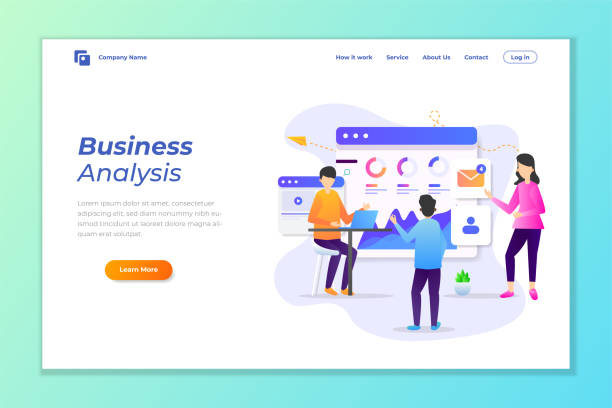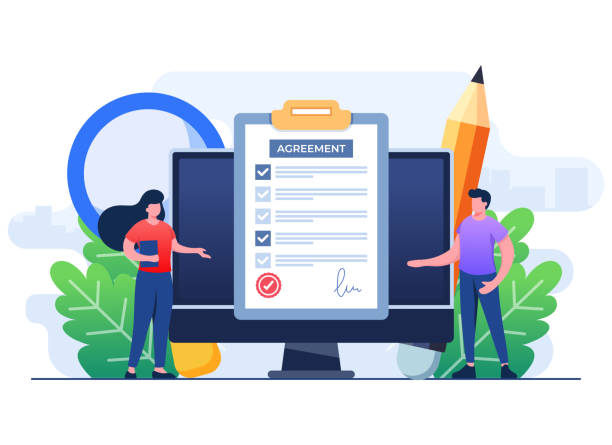Introduction and Importance of SEO-Optimized Website Design

In today’s digital age, having a website is just the first step.
What truly matters is the visibility of that website among billions of pages on the internet.
This is where the concept of #SEO_optimized_website_design comes in.
A merely beautiful website, without adhering to SEO principles, is like a luxurious shop in a dead-end alley that no customer can find.
SEO, or Search Engine Optimization, is a process that ensures your website is understandable and valuable to search engines like Google, allowing it to achieve higher rankings in search results.
The ultimate goal of designing a search engine optimized site is to attract organic and targeted traffic, which in turn leads to increased brand awareness, higher sales, and business growth.
The importance of this issue is such that today, any investment in website design must be accompanied by an SEO-centric approach.
Ignoring SEO in the initial design stages can lead to exorbitant costs for future reconstruction and optimization.
Therefore, for any business seeking a strong and sustainable online presence, SEO-optimized website design is a vital and undeniable necessity.
This approach forms the foundation of long-term success in the digital world and paves the way for achieving marketing goals.
Are you dissatisfied with the low sales of your online store?
RasaWeb is your solution for having a professional and high-selling online store.
✅ Significant increase in sales and revenue
✅ Easy and enjoyable shopping experience for customers
⚡ Get a free consultation from RasaWeb now!
Core Principles of SEO-Optimized Website Design

To begin the process of SEO-optimized website design, understanding the core principles of SEO is essential.
These principles include keyword research, quality content creation, and technical SEO.
#Keyword_research is the first step and involves identifying the phrases your target audience uses in search engines to find your products or services.
The correct selection of keywords provides the foundation for content structuring and page optimization.
After that, it’s time for #quality_content_creation.
Content that is both valuable to users and understandable to search engines.
This content should address user needs, answer their questions, and provide comprehensive and accurate information.
The natural and logical use of keywords in content, without exaggeration or excessive repetition (known as keyword stuffing), is of high importance.
Content quality not only helps improve SEO rankings but also enhances user experience.
The third and crucial part is #technical_SEO, which involves optimizing the technical aspects of the website so that search engines can easily crawl and index your site.
This includes a friendly URL structure, the use of sitemaps, robots.txt file, and ensuring the site’s responsiveness for various devices.
Integrating these principles from the very beginning of the design process not only helps save time and money but also significantly increases the chances of success for a search engine optimized website.
Understanding and correctly applying these foundations is the cornerstone of a powerful and visible website in the online world.
Technical Structure and Website Speed Optimization for SEO

Technical structure and loading speed are two critical factors in SEO-optimized website design that are often overlooked but have a profound impact on rankings and user experience.
#Site_structure refers to how pages are organized and internal navigation is set up.
A logical and hierarchical structure helps search engines easily find different pages and understand the relationships between them.
Using descriptive and short URLs, breadcrumbs, and logical internal links all contribute to improving the site’s crawlability and indexability.
This website SEO optimization is a specialized and very important aspect.
Website speed is another factor that Google places special importance on.
Websites that load quickly provide a better user experience and have a lower Bounce Rate.
These factors indirectly affect SEO.
To optimize speed, methods such as image compression, code optimization (CSS, JavaScript), caching, and utilizing a CDN (Content Delivery Network) can be used.
Tools like Google PageSpeed Insights can help you identify issues and provide solutions.
A website with a strong structure and high speed not only keeps users satisfied but also sends positive signals to search engines, leading to better rankings.
These aspects, in fact, form the foundation of a search engine optimized website.
In addition, a table of the most important technical factors affecting SEO is provided:
| Technical Factor | Description | Importance for SEO |
|---|---|---|
| Site Loading Speed | The time required to fully display website content to the user. | Direct ranking factor, improved user experience, and reduced bounce rate. |
| Mobile-Friendliness | The ability of the site to display correctly and function properly on mobile devices. | The most important factor in Google’s Mobile-First Indexing. |
| URL Structure | How web page addresses are organized and named. | Helps search engines understand page content, improves user experience. |
| Robots.txt File | A file that tells search engines which parts not to crawl. | Manages crawl budget, prevents unnecessary pages from being indexed. |
| XML Sitemap | A list of all important site pages for search engines. | Ensures all important pages are crawled and indexed. |
The Role of Content in SEO-Optimized Website Design
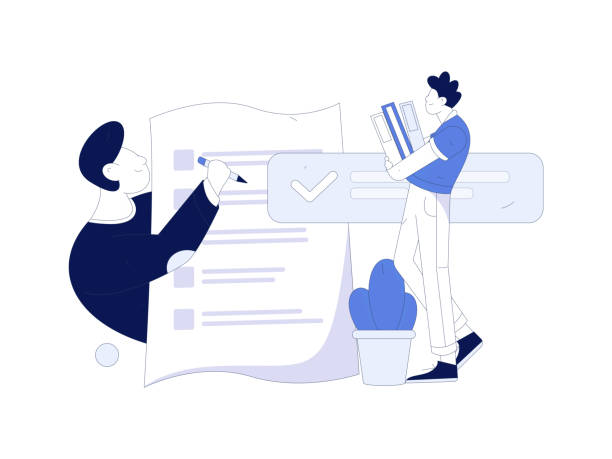
Content is the king that rules the throne of SEO-optimized website design.
Without high-quality and strategic content, even the best technical structure and speed optimization cannot lead to sustainable success.
#Content_strategy in SEO means producing content that not only meets users’ informational needs but also aligns with their #User_Intent.
Search engines are becoming increasingly smarter at understanding the intent behind user searches and prefer pages that precisely answer user questions or address their needs.
Producing #Evergreen_Content, which does not lose its value over time, is of particular importance; this type of content consistently attracts traffic and does not require frequent updates.
Various types of content can be included in a search engine optimized site, from blog articles and comprehensive guides to videos, infographics, and podcasts.
Content format diversity not only attracts more audiences but also signals to search engines that your site is a comprehensive and authoritative source.
Furthermore, content optimization includes appropriate use of headings (H1, H2, H3), relevant internal links, optimized images with alt text, and engaging meta descriptions.
A strong content strategy transforms your website into an authoritative reference in your field, and this authority directly leads to better search engine rankings.
This dynamic interaction between content and technical aspects is the heart of a successful SEO-optimized website design.
Are you worried about losing customers because you don’t have a professional online store?
With online store design by RasaWeb, forget these worries!
✅ Significant increase in sales and conversion rate from visitor to customer
✅ Professional and user-friendly design that builds customer trust
⚡ Get a free consultation from RasaWeb
User Experience (UX) and Its Impact on SEO

The relationship between User Experience (UX) and SEO is an inseparable synergy in SEO-optimized website design.
Google and other search engines increasingly rely on user experience-related factors as ranking signals.
#User_Experience not only affects visitor satisfaction but also directly impacts SEO metrics such as bounce rate, time on site, and conversion rate.
A site with poor UX, even with excellent content, may quickly lose users, and this sends a negative signal to search engines.
To improve #SEO_UX, factors such as easy and intuitive navigation, text readability, appealing visual design, and site responsiveness should be considered.
Responsive Design, which ensures the website displays correctly on all devices, including mobile and tablet, is an absolute necessity today.
With its Mobile-First Indexing approach, Google primarily considers the mobile version of your site for indexing.
Therefore, ensuring a flawless user experience on mobile is crucial.
Furthermore, using clear Call to Actions and clickable buttons, logical information layout, and reducing distracting elements all contribute to improved user engagement and consequently better SEO rankings.
When users have a positive experience on your site, they stay longer, view more pages, and are more likely to convert into customers.
These behaviors signal to search engines that your site is valuable and authoritative, and this is how a search engine optimized site improves its rankings by providing an excellent user experience.
Link Building and Site Authority in SEO-Optimized Website Design

Link building is one of the main pillars and perhaps the most challenging aspect of SEO-optimized website design.
Links act as “votes of confidence” from other websites and signal to search engines that your site possesses authority and expertise.
There are two main types of link building: internal links and external links (backlinks).
#Internal_link_building refers to the connections between different pages of your website and helps search engines better understand the site’s structure and transfer authority (PageRank) between pages.
Strategic use of internal links can help distribute “SEO value” across your site and highlight important pages.
#Backlinks, which point from other sites to your website, are of paramount importance.
The quality and authority of the linking site are more important than the quantity of links.
A backlink from an authoritative and relevant site in your industry can have a much greater impact than dozens of backlinks from irrelevant or low-quality sites.
Effective strategies for attracting backlinks include producing excellent and shareable content, connecting with bloggers and influencers, and utilizing Broken Link Building techniques.
Domain Authority is a metric that indicates the strength and credibility of a website in the eyes of search engines, and it is primarily influenced by the quality of its backlinks.
An SEO-optimized website design that focuses on strong and ethical link building gradually increases its authority and achieves higher rankings in search results.
This specialized aspect of SEO requires patience and continuous strategy.
Tools and Data Analysis in Website SEO

In the world of SEO-optimized website design, merely implementing principles is not enough; continuous monitoring and analysis of site performance are required.
This is where #SEO_tools and #data_analysis come into play.
These tools help SEO specialists and business owners evaluate their website’s performance in search engines, identify strengths and weaknesses, and adjust their strategies based on real data.
Google Search Console is an essential and free tool from Google that provides vital information about how your site is seen in search results (including keywords, popular pages, indexing issues).
Google Analytics is another free tool that provides deep insights into user behavior on your site (such as visitor count, time on site, pages viewed, conversion rate).
In addition to these free tools, there are more advanced paid tools like Ahrefs and SEMrush that offer broader capabilities in keyword research, backlink analysis, competitor analysis, and rank monitoring.
Correct interpretation of data from these tools is key to continuous and effective optimization.
For example, if you notice that a particular page has a high bounce rate, it might indicate irrelevant content or a poor user experience that needs correction.
A search engine optimized site uses this data to make informed decisions to continuously improve its performance and lead in the digital competition.
The use of these tools is an inseparable part of the SEO-optimized website design process.
In addition, a table of the most important SEO tools and their applications is provided:
| Tool Name | Main Application | Type (Free/Paid) |
|---|---|---|
| Google Search Console | Monitoring search performance, indexing issues, backlink status. | Free |
| Google Analytics | Analyzing site traffic, user behavior, traffic sources. | Free |
| Ahrefs | Keyword research, competitor analysis, backlink auditing, rank monitoring. | Paid (with limited trial) |
| SEMrush | Keyword research, competitor SEO analysis, PPC, local SEO. | Paid (with limited trial) |
| Moz Pro | Keyword research, link analysis, rank tracking, local SEO. | Paid (with limited trial) |
Challenges and Future Trends in SEO-Optimized Website Design
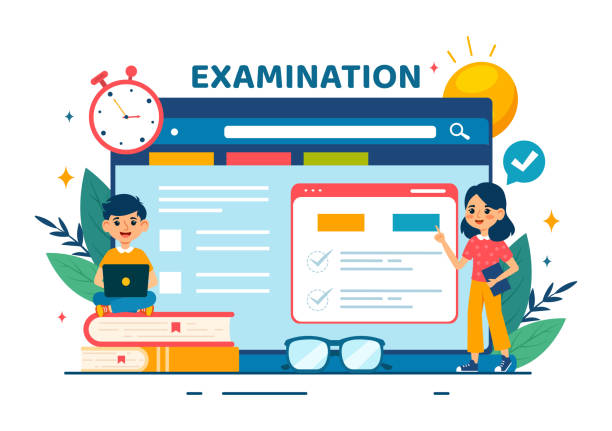
The world of SEO-optimized website design is constantly evolving and facing new challenges and trends.
To maintain rankings and visibility in search engines, awareness of and adaptation to these changes are essential.
One of the most important future trends is #voice_search.
With the increasing use of voice assistants like Siri and Alexa, optimizing for voice search, which usually involves longer and more question-based phrases, is gaining increasing importance.
Additionally, #AI_in_SEO will play a more prominent role, as Google’s algorithms like RankBrain and BERT are increasingly focusing on understanding content context and user intent.
This means that high-quality, comprehensive content that is naturally written will be more valuable than ever.
The E-A-T principle (Expertise, Authoritativeness, Trustworthiness) has also become one of the most important ranking factors, especially for sites in the health, finance, and legal sectors.
This principle emphasizes the importance of the author’s and website’s credibility in providing accurate and reliable information.
Challenges such as combating low-quality AI-generated content and the need to respect user privacy (e.g., GDPR and CCPA regulations) also add to the complexity of the SEO process.
A search engine optimized site must constantly adapt to these changes and leverage the latest technologies and best practices.
This dynamism provides new opportunities for growth and visibility in the online space and requires a dynamic and forward-thinking approach to website design.
Did you know that poor online store design can drive away up to 70% of your potential customers? RasaWeb transforms your sales with professional and user-friendly online store designs.
✅ Significant increase in sales and revenue
✅ Full optimization for search engines and mobile
⚡ [Get a free consultation from RasaWeb]
From Common Mistakes to Best Practices in SEO-Optimized Website Design
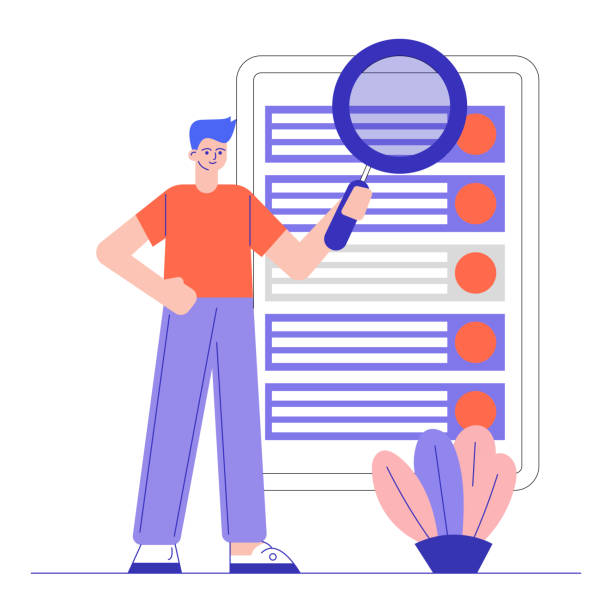
In the journey of SEO-optimized website design, avoiding #common_SEO_mistakes is as important as adhering to #best_practices.
One of the common mistakes is “keyword stuffing,” which means excessive repetition of a keyword in the text in hopes of improving rankings.
This practice is not only penalized by search engines but also severely degrades the user experience.
Duplicate Content is also another common problem; the presence of similar content on multiple pages can confuse search engines and harm the site’s credibility.
Ignoring mobile SEO and site speed are also major mistakes that we covered in previous sections.
Failure to use engaging and descriptive meta tags and meta descriptions also misses a great opportunity to attract clicks.
In contrast to these mistakes, best practices in SEO-optimized website design include the following: Firstly, producing valuable and unique content that naturally uses keywords.
Secondly, ensuring a clean and logical URL structure.
Thirdly, focusing on excellent User Experience (UX), especially for mobile.
Fourthly, building high-quality and relevant links (both internal and external).
And finally, continuous monitoring of site performance with SEO tools and implementing necessary changes based on data.
Adhering to these principles and avoiding common pitfalls can help a search engine optimized site achieve sustainable success.
White Hat SEO, meaning the use of ethical and search engine approved methods, is the only way to achieve sustainable rankings and long-term growth.
Investing in SEO-Optimized Website Design: A Smart Decision

In conclusion, it can be confidently stated that investing in SEO-optimized website design is not an expense, but a #smart_investment that yields a significant #Return_on_Investment (ROI).
In today’s competitive world, a mere online presence is not enough; what matters is that your business is visible among a multitude of competitors.
A search engine optimized site is a gateway to organic and targeted traffic that is continuously directed to your site without the need for exorbitant costs for paid advertising.
This quality traffic has a higher conversion probability and directly contributes to your #business_growth.
Designing and maintaining a website with strict adherence to SEO principles is an ongoing process that requires content updates, technical monitoring, and adaptation to changes in search algorithms.
But its results, namely increased visibility, improved brand credibility, and sustainable growth in sales and leads, are absolutely worth the effort.
Businesses that adopt an SEO-centric approach from the outset of their website design will gain a significant competitive advantage over their rivals and can transform their online presence into a powerful engine for customer acquisition.
Therefore, if you are looking for sustainable #online_success and increased market share, investing in SEO-optimized website design is not an option, but a requirement.
This strategic decision will pave the way for your success in the digital world.
Frequently Asked Questions
| Question | Answer |
|---|---|
| What is SEO-optimized website design? | SEO-optimized website design means creating a website that is not only attractive and user-friendly for users but also has its structure and content optimized for search engines (like Google) to achieve higher rankings in search results. |
| Why is SEO-optimized website design important? | SEO-optimized website design increases your website’s visibility in search engines, attracts more organic (free) traffic, boosts your brand’s credibility and trust, and ultimately leads to increased sales and customers. |
| What are the key factors in SEO-optimized website design? | Key factors include site loading speed, responsiveness (mobile compatibility), appropriate URL structure, correct use of title and meta description tags, image optimization, quality and user-friendly content, and internal and external link building. |
| What is the role of content in website SEO? | Content is king. High-quality, unique, relevant, and up-to-date content that naturally incorporates target keywords plays a very important role in attracting users and sending positive signals to search engines. |
| What impact does website speed have on SEO? | Website speed is one of Google’s important ranking factors. Slow sites provide a poor user experience and can increase the bounce rate, which harms your SEO ranking. |
| What does website responsiveness mean and why is it important for SEO? | Responsiveness means that your website displays correctly on any device (mobile, tablet, laptop). Since most searches are done via mobile, Google prioritizes responsive sites. |
| How do we choose appropriate keywords for the site? | Choosing appropriate keywords is done through research and analysis of user and competitor needs. Using tools like Google Keyword Planner, Ahrefs, or Semrush can help in finding high-volume and relevant keywords. |
| What is the importance of internal and external link building in SEO? | Internal link building helps improve site navigation, distribute Page Authority, and assist search engine crawling. External links (backlinks) from authoritative sites are also a sign of your site’s credibility and expertise to Google. |
| What is the role of user experience (UX) in SEO? | Good user experience means ease of use, visual appeal, and user satisfaction with the site. Good UX encourages users to stay on the site longer and interact more, which are considered positive signals for SEO ranking. |
| What tools are available for website SEO analysis? | There are numerous tools for SEO analysis, including Google Search Console for examining site performance in search, Google Analytics for traffic analysis, GTmetrix and PageSpeed Insights for speed assessment, and paid tools like Ahrefs and Semrush for comprehensive SEO and competitor analysis. |
And other services of RasaWeb Advertising Agency in the field of advertising:
Smart Marketing Automation: An effective tool to increase website traffic using real data.
Smart UI/UX: A combination of creativity and technology to improve SEO ranking through custom programming.
Smart SEO: An effective tool to increase sales using real data.
Smart Marketing Automation: A combination of creativity and technology to attract customers by optimizing key pages.
Smart Brand Identity: Professional optimization to improve SEO ranking by using real data.
And over hundreds of other services in internet advertising, advertising consultation, and organizational solutions.
Internet Advertising | Advertising Strategy | Native Advertising
Sources
SEO Website Design
Digital Success SEO
Importance of SEO in Website Design
Website Optimization for Search Engines
? RasaWeb Afarin Digital Marketing Agency, by providing comprehensive and innovative services, from fast website design to complex SEO strategies, paves the way for your business success in the online space.
📍 Tehran, Mirdamad Street, next to Bank Markazi, Southern Kazeroon Alley, Ramin Alley, No. 6

